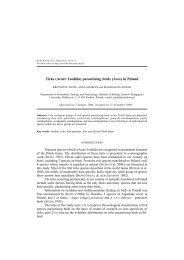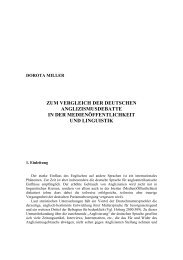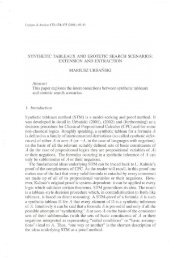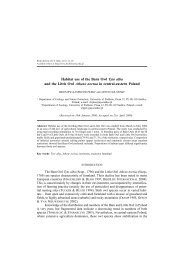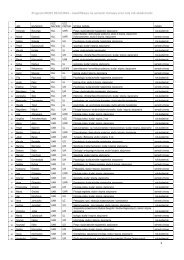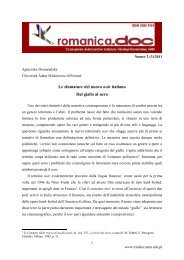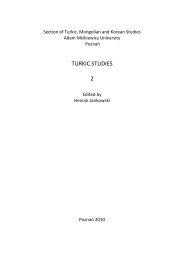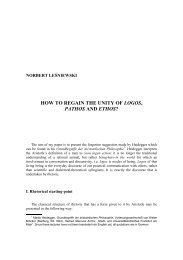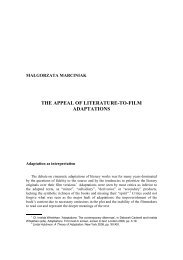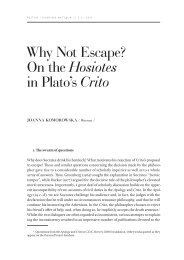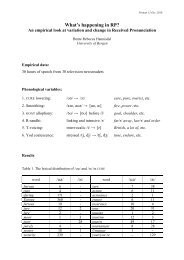Tarsonemid mites on ornamental plants in Poland: new data and an ...
Tarsonemid mites on ornamental plants in Poland: new data and an ...
Tarsonemid mites on ornamental plants in Poland: new data and an ...
You also want an ePaper? Increase the reach of your titles
YUMPU automatically turns print PDFs into web optimized ePapers that Google loves.
TARSONEMID MITES ON ORNAMENTAL PLANTS343AFig. 2. Phyt<strong>on</strong>emus pallidus fragariae: A – male; B – femaleBABFig. 3. Polyphagotars<strong>on</strong>emus latus: A – male; B – female
344 Gabriel £ab<strong>an</strong>owski <strong><strong>an</strong>d</strong> Gra¿yna SoikaABFig. 4. Steneotars<strong>on</strong>emus laticeps: A – male; B – female<strong>Pol<strong><strong>an</strong>d</strong></strong> this mite was discovered for the first time <strong>in</strong> the Bot<strong>an</strong>ical Garden <strong>in</strong> Pows<strong>in</strong>near Warsaw (SOIKA et al., 2004). Serious damage was observed <strong>on</strong> Aster dumosuscv. Peter Harris<strong>on</strong>, N<strong>an</strong>cy, Mount Everest (4 May’00) <strong><strong>an</strong>d</strong> <strong>on</strong> Aster novi-belgiii cv.Climax, Blue Eyes, Countess of Dudlet, N<strong>an</strong>cy Ballard (19 Oct’01). This mite feedsby suck<strong>in</strong>g sap <strong>in</strong>side develop<strong>in</strong>g flower buds <strong><strong>an</strong>d</strong> shoot tips <strong>on</strong> unfold<strong>in</strong>g leaflets oflate summer-flower<strong>in</strong>g perennial asters, except Aster novae-<strong>an</strong>gliae <strong><strong>an</strong>d</strong> A. amellus,which are more resist<strong>an</strong>t. The most obvious symptom of pest occurrence is poor flower<strong>in</strong>g;m<strong>an</strong>y blooms are c<strong>on</strong>verted <strong>in</strong>to rosettes of small leaves due to the <str<strong>on</strong>g>mites</str<strong>on</strong>g>’feed<strong>in</strong>g with<strong>in</strong> the develop<strong>in</strong>g buds. Infested <strong>pl<strong>an</strong>ts</strong> are also stunted <strong><strong>an</strong>d</strong> have brownishscarr<strong>in</strong>g <strong>on</strong> the stems.Polyphagotars<strong>on</strong>emus latus (B<strong>an</strong>ks, 1904) – broad mite. It is polyphagous <strong>on</strong>a wide assortment of <strong>ornamental</strong>s <strong><strong>an</strong>d</strong> some vegetable crops under covers. Forexample, <strong>in</strong> C<strong>on</strong>necticut (USA) it has a wide host r<strong>an</strong>ge <strong><strong>an</strong>d</strong> c<strong>an</strong> feed <strong>on</strong> Afric<strong>an</strong>violets, ageratums, beg<strong>on</strong>ias, cyclamens, dahlias, gerberas, glox<strong>in</strong>ias, hibiscus, ivy,jasm<strong>in</strong>e, impatiens, New Gu<strong>in</strong>ea impatiens, l<strong>an</strong>t<strong>an</strong>as, marigolds (Tagetes spp.), snapdrag<strong>on</strong>s,verbenas <strong><strong>an</strong>d</strong> z<strong>in</strong>nias (PUNDT 2005). Some more <strong>ornamental</strong> host specieswere found by DENMARK (2000): Aphel<strong><strong>an</strong>d</strong>ra sp., Cissus discolor, C. rotundifolia,Codiaeum variegatum, Fatsia jap<strong>on</strong>ica, Hoya carnosa, Pelarg<strong>on</strong>ium sp., Peperomiasp., Plectr<strong>an</strong>thus australis, Schefflera arboricola. In <strong>Pol<strong><strong>an</strong>d</strong></strong> it has become comm<strong>on</strong>s<strong>in</strong>ce 1982, when it was imported from the Netherl<strong><strong>an</strong>d</strong>s <strong>on</strong> gerbera seedl<strong>in</strong>gs(£ABANOWSKI et al. 1990). Up to now, we have observed it <strong>on</strong> 16 species of <strong>pl<strong>an</strong>ts</strong>bel<strong>on</strong>g<strong>in</strong>g to 14 families (Table 1). The broad mite feeds <strong>on</strong> the <strong>new</strong>est growth, caus<strong>in</strong>gmalformati<strong>on</strong> of the term<strong>in</strong>al leaves. They are severely stunted, hardened <strong><strong>an</strong>d</strong> curldown at the edges with brownish or reddish lower surfaces, depend<strong>in</strong>g <strong>on</strong> host spe-
TARSONEMID MITES ON ORNAMENTAL PLANTS345Table 1. Records of the broad mite (Polyphagotars<strong>on</strong>emus latus) <strong>on</strong> <strong>ornamental</strong> <strong>pl<strong>an</strong>ts</strong> <strong>in</strong> commercialglasshouses <strong>in</strong> <strong>Pol<strong><strong>an</strong>d</strong></strong>Pl<strong>an</strong>t family <strong><strong>an</strong>d</strong> speciesAc<strong>an</strong>thaceaeAphel<strong><strong>an</strong>d</strong>ra squarosaAmar<strong>an</strong>thaceaeCelosia cristataAraceaeAnthurium x hortul<strong>an</strong>umAraliaceaeFatshedera x lizeiHedera helixSchefflera arboricolaAsteraceaeGerbera james<strong>on</strong>iiBalsam<strong>in</strong>aceaeImpatiens novigu<strong>in</strong>eaBeg<strong>on</strong>iaceaeBeg<strong>on</strong>ia elatiorBign<strong>on</strong>iaceaeRadermachera s<strong>in</strong>icaGesneriaceaeSa<strong>in</strong>paulia i<strong>on</strong><strong>an</strong>thaNyctag<strong>in</strong>aceaeBouga<strong>in</strong>villea sp.PiperaceaePeperomia magnoliaeofoliaPrimulaceaeCyclamen persicumSol<strong>an</strong>aceaeSol<strong>an</strong>um capsicastrumVitaceaeCissus <strong>an</strong>tarcticaLocality <strong><strong>an</strong>d</strong> date£ódŸ, 27 Sep’00Kraków, 11 Jun’99Nowy Dwór Mazowiecki, 15 Mar’99Wieliszew near Nowy Dwór Mazowiecki, 7 Oct’97;Mys³owice near Katowice, 30 Nov’90; Pabi<strong>an</strong>ice, 6 Oct’90;Skierniewice, 3 Feb’93, 11 Oct’2005; Wieliszew, 7 Oct’97Ró¿<strong>an</strong>ki near Gorzów, 6 Oct’90; Pruh<strong>on</strong>ice near Praha,23 Jun’87Czêstochowa, 28 Sep’85; Ka³uszyn near Siedlce, 5 Aug’91;Kraków, 8 Aug’00; £ódŸ, 17 Apr’85; 13 J<strong>an</strong>’97, 28 Oct’88;Pabi<strong>an</strong>ice near £ódŸ, 26 Sep’91; Skierniewice, 26 Jun’94;16 Sep’05Opole, 5 Jul’04; Warsaw, 10 Apr’06Kraków, 11 Jun’99; £ódŸ, 27 Aug’00; Skierniewice,9 Oct’01, 13 Sep’05; Wola Warszawska, 18 May’03Skierniewice, 28 Nov’97; Wieliszew near Nowy DwórMazowiecki, 28 Aug’97; Wola Warszawska, 11 Jul’98Wola Warszawska, 18 May’03Skierniewice, 21 Oct’05Skierniewice, 29 Oct’01Skierniewice, 6 Dec’01Wieliszew near Nowy Dwór Mazowiecki, 7 Oct’97Mys³owice near Katowice, 30 Nov’90cies. The body of males (Fig. 3A) is oval, 168 :m l<strong>on</strong>g, broadest at mid-length(97 :m), prodorsum with 3–4 pairs of dorsal setae (DENMARK 2000).Steneotars<strong>on</strong>emus laticeps (Halbert, 1923) – bulb scale mite. It is oligophagous<strong>on</strong> <strong>pl<strong>an</strong>ts</strong> of the family Amaryllidaceae. In Brita<strong>in</strong> it is a pest of narcissus bulbs,which causes brown scars <strong>on</strong> <strong>on</strong>e or more of the bulb scales <strong>in</strong> the neck regi<strong>on</strong> <strong>in</strong>
346 Gabriel £ab<strong>an</strong>owski <strong><strong>an</strong>d</strong> Gra¿yna Soikathe dorm<strong>an</strong>t period, it deforms leaves (giv<strong>in</strong>g a “saw-edge” effect) <strong><strong>an</strong>d</strong> reduces thequality of flowers (LANE 1979). In <strong>Pol<strong><strong>an</strong>d</strong></strong> it was found for the first time <strong>on</strong> Hippeastrumsp. <strong>on</strong> 14 Mar’84 (£ABANOWSKI et al. 1990) <strong><strong>an</strong>d</strong> it was sampled from narcissusbulbs imported from the Netherl<strong><strong>an</strong>d</strong>s, the United K<strong>in</strong>gdom <strong><strong>an</strong>d</strong> Germ<strong>an</strong>y(KARNKOWSKI 1995). Up to now we also have observed the damage <strong>on</strong> Eucharis sp.<strong><strong>an</strong>d</strong> Narcissus sp. imported from the Netherl<strong><strong>an</strong>d</strong>s. The males (Fig. 4A) have 4 pairsof prodorsal setae; femur IV does not have <strong>an</strong>y fl<strong>an</strong>ge-like process <strong>on</strong> the <strong>in</strong>ner marg<strong>in</strong>;the tactile seta <strong>on</strong> tibia IV is short <strong><strong>an</strong>d</strong> not as l<strong>on</strong>g as the femoral segment. Thegnathosoma is subcircular <strong><strong>an</strong>d</strong> the third pair of prodorsal setae are 2/3 as l<strong>on</strong>g as thewidth of the gnathosoma. The body of females is el<strong>on</strong>gate, legs I <strong><strong>an</strong>d</strong> II are widelyseparated from legs III <strong><strong>an</strong>d</strong> IV. There are 2 pairs of prodorsal hair-like setae (JEPP-SON et al. 1975).CONCLUSIONS1. On <strong>ornamental</strong> <strong>pl<strong>an</strong>ts</strong> <strong>in</strong> glasshouses, we recorded 3 species of tars<strong>on</strong>emid<str<strong>on</strong>g>mites</str<strong>on</strong>g> as pests: Polyphagotars<strong>on</strong>emus latus, very comm<strong>on</strong> <strong>on</strong> m<strong>an</strong>y cut flowers <strong><strong>an</strong>d</strong>potted <strong>pl<strong>an</strong>ts</strong>; Phyt<strong>on</strong>emus pallidus pallidus, very rare <strong>on</strong> azaleas <strong><strong>an</strong>d</strong> chrys<strong>an</strong>themum,not found <strong>on</strong> cyclamens; <strong><strong>an</strong>d</strong> Steneotars<strong>on</strong>emus laticeps, associated withamaryllidaceous <strong>pl<strong>an</strong>ts</strong>, ma<strong>in</strong>ly Hippeastrum spp.2. Phyt<strong>on</strong>emus pallidus asteris causes serious damage <strong>in</strong> the field <strong>on</strong> late summer-flower<strong>in</strong>gperennial asters: Aster dumosus <strong><strong>an</strong>d</strong> A. novi-belgii.Acknowledgments: We th<strong>an</strong>k Dr WOJCIECH MAGOWSKI, A. Mickiewicz University, Poznañ, foridentificati<strong>on</strong> of Phyt<strong>on</strong>emus pallidus asteris.REFERENCESDENMARK H. A. 2000. Broad mite, Polyphagotars<strong>on</strong>emus latus (B<strong>an</strong>ks) (Arachnida: Acar<strong>in</strong>a:<str<strong>on</strong>g>Tars<strong>on</strong>emid</str<strong>on</strong>g>ae). EENY-183. University of Florida. IFAS Extensi<strong>on</strong>, http://creatures.ifas.ufl.edu,3 pp.JEPPSON L. R., KEIFER H. H., BAKER E. W. 1975. Mites <strong>in</strong>jurious to ec<strong>on</strong>omic <strong>pl<strong>an</strong>ts</strong>. Ch. 10.<str<strong>on</strong>g>Tars<strong>on</strong>emid</str<strong>on</strong>g>ae Kramer. pp. 285–305, University of California Press, Berkeley.KARL VON E. 1965. Untersuchungen zur Morphologie und Ökologie v<strong>on</strong> <str<strong>on</strong>g>Tars<strong>on</strong>emid</str<strong>on</strong>g>en gärtnerischerKulturpfl<strong>an</strong>zen. I. Tars<strong>on</strong>emus pallidus B<strong>an</strong>ks. Biol. Zentralblatt. 47–80.KARNKOWSKI W. 1995. Method for exam<strong>in</strong>ati<strong>on</strong> of Narcissus bulbs to detect the bulb scale mite(Steneotars<strong>on</strong>emus laticeps Helbert) (Acar<strong>in</strong>a: <str<strong>on</strong>g>Tars<strong>on</strong>emid</str<strong>on</strong>g>ae). Proc. Symp. On “Adv<strong>an</strong>cy ofAcarology <strong>in</strong> <strong>Pol<strong><strong>an</strong>d</strong></strong>”, Siedlce, September 26–27, 1995 (BOCZEK J., IGNATOWICZ S., Eds),pp. 106–110.LANE A. 1979. Bulb scale mite. M<strong>in</strong>istry of Agriculture, Fisheries <strong><strong>an</strong>d</strong> Food. Leaflet 456, 6 pp.£ABANOWSKI G. S., £ABANOWSKA B. H., SUSKI Z. W., 1990. New species of <str<strong>on</strong>g>mites</str<strong>on</strong>g> (Acar<strong>in</strong>a) <strong>in</strong>the fauna of <strong>Pol<strong><strong>an</strong>d</strong></strong>. Zesz. Probl. Post. Nauk Rol., 373: 9–17.PUNDT L. 2005. M<strong>an</strong>ag<strong>in</strong>g cyclamen <str<strong>on</strong>g>mites</str<strong>on</strong>g> <strong><strong>an</strong>d</strong> broad <str<strong>on</strong>g>mites</str<strong>on</strong>g> <strong>in</strong> Greenhouse eith <strong>new</strong> images J<strong>an</strong>uary2005. http://www.hort.uc<strong>on</strong>n.edu/ipm/greenhs/htms/cycl<str<strong>on</strong>g>mites</str<strong>on</strong>g>.htm, 3 pp.SOIKA G., £ABANOWSKI G. S., BRZOZOWSKA-MICHALAK J. 2004. The occurrence of phytophagous<str<strong>on</strong>g>mites</str<strong>on</strong>g> <strong><strong>an</strong>d</strong> <strong>in</strong>sects <strong>on</strong> perennials <strong>in</strong> bot<strong>an</strong>ical gardens <strong><strong>an</strong>d</strong> urb<strong>an</strong> areas <strong>in</strong> <strong>Pol<strong><strong>an</strong>d</strong></strong>. In: Protecti<strong>on</strong>of pl<strong>an</strong>t collecti<strong>on</strong>s aga<strong>in</strong>st pests <strong><strong>an</strong>d</strong> diseases (WIECH K., ZEMANEK B., Eds). Vol. II, pp. 30–37, Oficyna Wydawnicza TEXT, Kraków.Associate editor: ANNA SKORACKA




